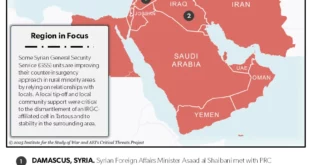Iran allowed UN inspectors to revisit a heavy-water reactor site on Monday, a place off-limits since April, in a show of transparency meant to help ward off harsher UN sanctions over its disputed nuclear activity.Iran agreed to grant International Atomic Energy Agency (IAEA) inspectors fresh access to the Arak complex under construction as part of an “action plan†to defuse suspicions of a covert atom bomb project, as demanded by the UN Security Council.
Tehran has refused the Council’s main demand that it suspend all efforts to produce nuclear fuel — defiance that has saddled the Islamic republic with two sets of modest sanctions.
But diplomats say Iran hopes to pre-empt more punishing sanctions by answering IAEA questions about its activity and improve IAEA access to sensitive sites. Iran’s initiative led big powers to put off more sanctions at least until September.
Tehran barred inspectors from Arak four months ago to protest at a second round of sanctions, insisting its programme — centred on its Natanz uranium enrichment plant—is solely to yield electricity, not explosives.
An IAEA official in Vienna confirmed an inspection was carried out at the Arak research reactor site, but declined to elaborate, saying details would be come in a report to the next meeting of the IAEA’s 35-nation board of governors in September.
Iran’s official news agency IRNA said the inspectors spent five hours at Arak. The semi-official Fars news agency said three inspectors visited Arak and would conduct “routine checks†at other nuclear sites in the country over the next week.
Diplomats said the Arak visit would be a one-off to check that Iran was adhering to construction design data given earlier to the IAEA. The two sides have yet to negotiate a restoration of regular IAEA design-verification trips to Arak.
Iran says Arak, due for completion in 2009, will produce radio-isotopes for medical care and agriculture. Western officials fear it could yield plutonium, one of the two prime components — besides highly enriched uranium — in atom bombs.
The risk of the reactor being configured to churn out plutonium would rise without effective UN monitoring.
As part of transparency moves, Iran also agreed to finalise steps at talks with the IAEA in Tehran on August 6 to enhance monitoring at Natanz, where inspectors up to now have been unable to enter its hall of centrifuge enrichment machines.
Higher-level talks are set for August 20 to resolve thorny issues that arose from Iran’s cover-up of atomic research from the IAEA until 2003, raising suspicion of military diversions.
Western diplomats and analysts are sceptical Iran will come clean completely in the short term, believing it may make just enough concessions to cement Russian opposition to biting sanctions and buy time to master enrichment technology.
“Iran’s strategy is to put off the next sanctions resolution by demonstrating greater cooperation on IAEA safeguards issues,†said Gary Samore, a former senior US security official now head of studies at the Council on Foreign Relations in New York.
“Iran may cooperate just enough for the IAEA to argue in September for more time to resolve the issues and ask that the Security Council not take more action as Iran would only retaliate by further restricting the IAEA’s monitoring ability.â€
 Eurasia Press & News
Eurasia Press & News


